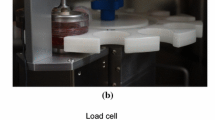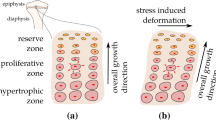Abstract
Mechanical environment is one of the regulating factors involved in the process of longitudinal bone growth. Non-physiological compressive loading can lead to infantile and juvenile musculoskeletal deformities particularly during growth spurt. We hypothesized that tissue mechanical behavior in sub-regions (reserve, proliferative and hypertrophic zones) of the growth plate is related to its collagen and proteoglycan content as well as its collagen fiber orientation. To characterize the strain distribution through growth plate thickness and to evaluate biochemical content and collagen fiber organization of the three histological zones of growth plate tissue. Distal ulnar growth plate samples (N = 29) from 4-week old pigs were analyzed histologically for collagen fiber organization (N = 7) or average zonal thickness (N = 8), or trimmed into the three average zones, based on the estimated thickness of each histological zone, for biochemical analysis of water, collagen and glycosaminoglycan content (N = 7). Other samples (N = 7) were tested in semi-confined compression under 10 % compressive strain. Digital images of the fluorescently labeled nuclei were concomitantly acquired by confocal microscopy before loading and after tissue relaxation. Strain fields were subsequently calculated using a custom-designed 2D digital image correlation algorithm. Depth-dependent compressive strain patterns and collagen content were observed. The proliferative and hypertrophic zone developed the highest axial and transverse strains, respectively, under compression compared to the reserve zone, in which the lowest axial and transverse strains arose. The collagen content per wet mass was significantly lower in the proliferative and hypertrophic zones compared to the reserve zone, and all three zones had similar glycosaminoglycan and water content.Polarized light microscopy showed that collagen fibers were mainly organized horizontally in the reserve zone and vertically aligned with the growth direction in the proliferative and hypertrophic zones. Higher strains were developed in growth plate areas (proliferative and hypertrophic) composed of lower collagen content and of vertical collagen fiber organization. The stiffer reserve zone, with its higher collagen content and collagen fibers oriented to restrain lateral expansion under compression, could play a greater role of mechanical support compared to the proliferative and hypertrophic zones, which could be more susceptible to be involved in an abnormal growth process.
Similar content being viewed by others
Abbreviations
- DIC:
-
Digital image correlation
- ROI:
-
Region of interest
- DMMB:
-
1,9-Dimethylmethylene blue
- OH-Pro:
-
Hydroxyproline
- GAG:
-
Glycosaminoglycan
- S-GAG:
-
Sulfated glycosaminoglycan
- PG:
-
Proteoglycan
- GP:
-
Growth plate
References
Alini M, Matsui Y, Dodge GR, Poole AR (1992) The extracellular matrix of cartilage in the growth plate before and during calcification: changes in composition and degradation of type II collagen. Calcif Tissue Int 50(4): 327–335
Amini S, Veilleux D, Villemure I (2010) Tissue and cellular morphological changes in growth plate explants under compression. J Biomech 43(13): 2582–2588. doi:10.1016/j.jbiomech.2010.05.010
Anderson HC (1995) Molecular biology of matrix vesicles. Clin Orthop Relat Res 314: 266–280
Ballock RT, O’Keefe RJ (2003a) The biology of the growth plate. J Bone Jt Surg Am 85-A(4): 715–726
Ballock RT, O’Keefe RJ (2003b) Physiology and pathophysiology of the growth plate. Birth Defects Res C Embryo Today 69(2): 123–143. doi:10.1002/bdrc.10014
Bonnel F, Dimeglio A, Baldet P, Rabischong P (1984) Biomechanical activity of the growth plate. Clinical incidences. Anat Clin 6(1): 53–61
Buckwalter JA, Mower D, Ungar R, Schaeffer J, Ginsberg B (1986) Morphometric analysis of chondrocyte hypertrophy. J Bone Jt Surg Am 68(2): 243–255
Byers S, van Rooden JC, Foster BK (1997) Structural changes in the large proteoglycan, aggrecan, in different zones of the ovine growth plate. Calcif Tissue Int 60(1): 71–78
Cancel M, Grimard G, Thuillard-Crisinel D, Moldovan F, Villemure I (2009) Effects of in vivo static compressive loading on aggrecan and type II and X collagens in the rat growth plate extracellular matrix. Bone 44(2): 306–315. doi:10.1016/j.bone.2008.09.005
Changoor A, Tran-Khanh N, Methot S, Garon M, Hurtig MB, Shive MS, Buschmann MD (2011) A polarized light microscopy method for accurate and reliable grading of collagen organization in cartilage repair. Osteoarthr Cartil 19(1): 126–135. doi:10.1016/j.joca.2010.10.010
Cheng P, Sutton M, Schreier H, McNeill S (2002) Full-field speckle pattern image correlation with B-Spline deformation function. Exp Mech 42(3): 344–352. doi:10.1177/001448502321548445
Cohen B, Chorney GS, Phillips DP, Dick HM, Buckwalter JA, Ratcliffe A, Mow VC (1992) The microstructural tensile properties and biochemical composition of the bovine distal femoral growth plate. J Orthop Res 10(2): 263–275. doi:10.1002/jor.1100100214
Cohen B, Chorney GS, Phillips DP, Dick HM, Mow VC (1994) Compressive stress-relaxation behavior of bovine growth plate may be described by the nonlinear biphasic theory. J Orthop Res 12(6): 804–813. doi:10.1002/jor.1100120608
Cohen B, Lai WM, Mow VC (1998) Transversely isotropic biphasic model for unconfined compression of growth plate and chondroepiphysis. J Biomech Eng Trans ASME 120(4): 491–496
Farnum CE, Wilsman NJ (1998) Chapter 13: Growth plate cellular function. In: Buckwalter JA, Ehrlich MG, Sandell LJ, Trippel SB (eds) Advances in the basis and clinical understanding of the growth plate. American Academy of Orthopaedic Surgeons, Chicago, pp 203–223
Farnum CE, Nixon A, Lee AO, Kwan DT, Belanger L, Wilsman NJ (2000) Quantitative three-dimensional analysis of chondrocytic kinetic responses to short-term stapling of the rat proximal tibial growth plate. Cells Tissues Organs 167(4): 247–258
Frost HM (1990) Skeletal structural adaptations to mechanical usage (SATMU): 3. The hyaline cartilage modeling problem. Anat Rec 226(4): 423–432. doi:10.1002/ar.1092260404
Fujii T, Takai S, Arai Y, Kim W, Amiel D, Hirasawa Y (2000) Microstructural properties of the distal growth plate of the rabbit radius and ulna: biomechanical, biochemical, and morphological studies. J Orthop Res 18(1): 87–93
Gannon JM, Walker G, Fischer M, Carpenter R, Thompson RC Jr., Oegema TR Jr. (1991) Localization of type X collagen in canine growth plate and adult canine articular cartilage. J Orthop Res 9(4): 485–494. doi:10.1002/jor.1100090404
Hoemann C, Kandel R, Roberts S, Saris DBF, Creemers L, Mainil-Varlet P, Méthot S, Hollander AP, Buschmann MD (2011) International Cartilage Repair Society (ICRS) recommended guidelines for histological endpoints for cartilage repair studies in animal models and clinical trials. Cartilage 2(2): 153–172. doi:10.1177/1947603510397535
Hoemann CD (2004) Cartilage and Osteoarthritis. In: De Ceuninck F, Sabatini M, Pastoureau P (eds) Methods in molecular medicine, vol 101. vol 2 structure and in vivo analysis, 2004/08/10 edn, pp 127–156. doi:10.1385/1-59259-821-8:127
Hoemann CD, Sun J, Chrzanowski V, Buschmann MD (2002) A multivalent assay to detect glycosaminoglycan, protein, collagen, RNA, and DNA content in milligram samples of cartilage or hydrogel-based repair cartilage. Anal Biochem 300(1): 1–10. doi:10.1006/abio.2001.5436
Hunziker EB, Schenk RK (1989) Physiological mechanisms adopted by chondrocytes in regulating longitudinal bone growth in rats. J Physiol 414: 55–71
Jacenko O, LuValle PA, Olsen BR (1993) Spondylometaphyseal dysplasia in mice carrying a dominant negative mutation in a matrix protein specific for cartilage-to-bone transition. Nature 365(6441): 56–61. doi:10.1038/365056a0
Lehmann TM, Gonner C, Spitzer K (1999) Survey: interpolation methods in medical image processing. IEEE Trans Med Imaging 18(11): 1049–1075. doi:10.1109/42.816070
LeVeau BF, Bernhardt DB (1984) Developmental biomechanics. Effect of forces on the growth, development, and maintenance of the human body. Phys Ther 64(12): 1874–1882
Matsui Y, Alini M, Webber C, Poole AR (1991) Characterization of aggregating proteoglycans from the proliferative, maturing, hypertrophic, and calcifying zones of the cartilaginous physis. J Bone Jt Surg Am 73(7): 1064–1074
Mwale F, Tchetina E, Wu CW, Poole AR (2002) The assembly and remodeling of the extracellular matrix in the growth plate in relationship to mineral deposition and cellular hypertrophy: an in situ study of collagens II and IX and proteoglycan. J Bone Miner Res 17(2): 275–283
Radhakrishnan P, Lewis NT, Mao JJ (2004) Zone-specific micromechanical properties of the extracellular matrices of growth plate cartilage. Ann Biomed Eng 32(2): 284–291. doi:10.1023/B:ABME.0000012748.41851.b4
Sachs F (1991) Mechanical transduction by membrane ion channels: a mini review. Mol Cell Biochem 104(1–2): 57–60
Sergerie K, Lacoursiere MO, Levesque M, Villemure I (2009) Mechanical properties of the porcine growth plate and its three zones from unconfined compression tests. J Biomech 42(4): 510–516. doi:10.1016/j.jbiomech.2008.11.026
Speer DP (1982) Collagenous architecture of the growth plate and perichondrial ossification groove. J Bone Jt Surg Am 64(3): 399–407
Stokes IA, Mente PL, Iatridis JC, Farnum CE, Aronsson DD (2002) Enlargement of growth plate chondrocytes modulated by sustained mechanical loading. J Bone Jt Surg Am 84-A(10): 1842–1848
Stokes IA, Aronsson DD, Dimock AN, Cortright V, Beck S (2006) Endochondral growth in growth plates of three species at two anatomical locations modulated by mechanical compression and tension. J Orthop Res 24(6): 1327–1334. doi:10.1002/jor.20189
Stokes IA, Clark KC, Farnum CE, Aronsson DD (2007) Alterations in the growth plate associated with growth modulation by sustained compression or distraction. Bone 41(2): 197–205. doi:10.1016/j.bone.2007.04.180
Tong W (2005) An evaluation of digital image correlation criteria for strain mapping applications. Strain 41(4): 167–175. doi:10.1111/j.1475-1305.2005.00227.x
Villemure I, Cloutier L, Matyas JR, Duncan NA (2007) Non-uniform strain distribution within rat cartilaginous growth plate under uniaxial compression. J Biomech (UK) 40(1): 149–156. doi:10.1016/j.jbiomech.2005.11.008
Villemure I, Stokes IA (2009) Growth plate mechanics and mechanobiology. a survey of present understanding. J Biomech (UK) 42(12): 1793–1803. doi:10.1016/j.jbiomech.2009.05.021
Vu TH, Shipley JM, Bergers G, Berger JE, Helms JA, Hanahan D, Shapiro SD, Senior RM, Werb Z (1998) MMP-9/gelatinase B is a key regulator of growth plate angiogenesis and apoptosis of hypertrophic chondrocytes. Cell 93(3): 411–422
Watson PA (1991) Function follows form: generation of intracellular signals by cell deformation. FASEB J 5(7): 2013–2019
Wosu R, Sergerie K, Levesque M, Villemure I (2011) Mechanical properties of the porcine growth plate vary with developmental stage. Biomech Model Mechanobiol. doi:10.1007/s10237-011-0310-6
Wuthier RE (1969) A zonal analysis of inorganic and organic constituents of the epiphysis during endochondral calcification. Calcif Tissue Res 4(1): 20–38
Author information
Authors and Affiliations
Corresponding author
Rights and permissions
About this article
Cite this article
Amini, S., Mortazavi, F., Sun, J. et al. Stress relaxation of swine growth plate in semi-confined compression: depth dependent tissue deformational behavior versus extracellular matrix composition and collagen fiber organization. Biomech Model Mechanobiol 12, 67–78 (2013). https://doi.org/10.1007/s10237-012-0382-y
Received:
Accepted:
Published:
Issue Date:
DOI: https://doi.org/10.1007/s10237-012-0382-y




